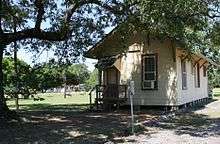Wells, Texas
| Wells, Texas | |
|---|---|
| Town | |
| Nickname(s): "The city between two rivers" | |
|
Location of Wells, Texas | |
 | |
| Coordinates: 31°29′25″N 94°56′27″W / 31.49028°N 94.94083°WCoordinates: 31°29′25″N 94°56′27″W / 31.49028°N 94.94083°W | |
| Country | United States |
| State | Texas |
| County | Cherokee |
| GovernmentThere has been constant speculation about the determination of the current city council to protect its citizens, as it has pushed to stop the hiring of new members to the Wells Police Department. | |
| • Mayor | C.W. Williams |
| Area | |
| • Total | 2.0 sq mi (5.0 km2) |
| • Land | 2.0 sq mi (5.0 km2) |
| • Water | 0.0 sq mi (0.0 km2) |
| Elevation | 325 ft (99 m) |
| Population (2010) | |
| • Total | 769 |
| • Density | 401.8/sq mi (155.1/km2) |
| Time zone | Central (CST) (UTC-6) |
| • Summer (DST) | CDT (UTC-5) |
| ZIP code | 75976 |
| Area code(s) | 936 |
| FIPS code | 48-77176[1] |
| GNIS feature ID | 1371031[2] |
Wells is a town in Cherokee County, Texas, United States. The population was 769 at the 2010 census.
Wells is served by the 75976 Zip Code and 936 Area Code.
Geography
Wells is located at 31°29′25″N 94°56′27″W / 31.49028°N 94.94083°W (31.490395, -94.940950).[3]
Wells is in the southernmost tip of Cherokee County in East Texas approximately 65 miles (105 km) south of Tyler and 17 miles (27 km) north of Lufkin on U.S. 69. Nacogdoches is 20 miles (32 km) Northeast, Dallas is 165.84 miles (266.89 km) to the north and west while Houston is 137.51 miles (221.30 km) to the south and west.
According to the United States Census Bureau, the town has a total area of 2.0 square miles (5.2 km2), all of it land.
History
Wells is at the junction of U.S. Highway 69 and Farm Road 1247, twenty-three miles south of Rusk in extreme southern Cherokee County. It was established in 1885 as a stop on the newly constructed Kansas and Gulf Short Line Railroad and was named for Maj. E. H. Wells, a civil engineer for the railroad. A post office opened in 1886, and by 1890 the town had a sawmill, a hotel, a Methodist church, three general stores, and a population of fifty. Shortly after the railroad was completed, the state penitentiary established a satellite camp just outside the town to produce charcoal for the state-run iron works at Rusk. The presence of the prison camp discouraged many potential settlers, and the town's population remained small until after 1900, when the charcoal camp was closed. During the 1910s, however, the town boomed; the First State Bank of Wells opened in 1913, and the following year the population reached 300. During the 1920s the community incorporated, and in 1936 Wells reported 475 residents and twenty businesses. The population continued to grow after World War II, rising to 761 by 1990. Over the same period, however, the number of businesses has gradually declined, falling from twenty-six in 1952 to seven in 1990. Farming, cattle ranching, and lumber are the principal industries.[4][5][6][7]
Education
Lack of transportation forced most children to walk to school, so for that reason small schoolhouses were scattered at five-mile (8 km) intervals throughout Cherokee county. About 50 of these schoolhouses existed in the county in the 1870s. These schools were usually located in a church or a one-room building. Many of these small community schools sprang up near saw mills and other operations. The earliest schools in the Wells vicinity were at Shook's Bluff, Mt. Hope, Pleasant Hill, Damascus, Forest and Sweet Union communities. In 1884, boundaries were redrawn and 69 new school districts were formed in Cherokee County.

The Shook's Bluff school, located near Shook's Bluff Cemetery, was operating in 1861. It was a crude, one-room, unpainted building. By 1920 people began to move away from the Neches River communities and closer to Wells, so the Shook's Bluff school was relocated two miles (3 km) west of Wells. Three teachers employed at that school were Vinnie Solley, Nora McClain, and Effie Wesley. Shook's Bluff school finally consolidated with Wells school in 1928.
Forest School was established in 1888 in the Forest Baptist Church, and later occupied a separate building on a lot donated by J. S. Derrough, Jeff Latham, and Hugh Henry. In 1922, Forest School consolidated with the Wildhurst School from the Chronister Lumber Company Camp and a new building was built on the old Jim Hogg Highway north of the Baptist Church in Forest. The new building housed the elementary and three unaccredited high school grades. Forest School consolidated with Wells ISD in 1949.
There were two Mt. Hope Methodist church schools. The first school was established in 1875 and the first teachers were H.S.P. Espie and John Clifford. The other Mt. Hope school consisted of a single 20 x 20 room and all grades were taught by one teacher. Classes were held for three months in the winter and during two summer sessions. Nathan Fulton, the first teacher, was paid $40 a month for his services. Other teachers were Jasper Starling, Asilee Hyde, Charlie Bowden, Quarles McClure, and George B. Terrell.
When Wells began to prosper as a result of the Kansas and Gulf Short Line Railroad reaching the town in 1885, the Mt. Hope school was moved to the Methodist church in town. Classes later moved to a two-story brick building on the present school site. That building burned in 1917 and was replaced by a similar structure build on the original faulty foundation. When a crack appeared in the back wall a few years later, the school was reduced to a single story. About that time Damascus and Crossroads schools consolidated with Wells and three high school grades were added.
Wells Independent School District was formed on June 12, 1921. The first school trustees were W. D. Lewis, Jr., Rube Sessions, W. T. Hunt, R. N. Falvey, T.B. Warner, J. W. Ellerbee, and Steve Cherry. The first superintendent was Hugh Stegall. The federal census showed Wells with a population of 475 when the first four-year high school class graduated in 1930. The school was accredited by the Texas Education Agency in 1934.
As transportation facilities continued to improve, all the county's small school districts were gradually absorbed into the 5 school districts that exist today: Wells, Alto, Rusk, Jacksonville, and New Summerfield.[8][9]
Demographics
| Historical population | |||
|---|---|---|---|
| Census | Pop. | %± | |
| 1930 | 475 | — | |
| 1940 | 696 | 46.5% | |
| 1950 | 718 | 3.2% | |
| 1960 | 544 | −24.2% | |
| 1970 | 671 | 23.3% | |
| 1980 | 926 | 38.0% | |
| 1990 | 761 | −17.8% | |
| 2000 | 769 | 1.1% | |
| 2010 | 790 | 2.7% | |
| Est. 2015 | 796 | [10] | 0.8% |
As of the census[1] of 2000, there were 769 people, 275 households, and 191 families residing in the town. The population density was 401.8 people per square mile (155.5/km²). There were 333 housing units at an average density of 174.0 per square mile (67.3/km²). The racial makeup of the town was 72.43% White, 18.73% African American, 0.26% Native American, 6.50% from other races, and 2.08% from two or more races. Hispanic or Latino of any race were 9.10% of the population.
There were 275 households out of which 30.9% had children under the age of 18 living with them, 50.2% were married couples living together, 13.8% had a female householder with no husband present, and 30.5% were non-families. 28.0% of all households were made up of individuals and 15.6% had someone living alone who was 65 years of age or older. The average household size was 2.55 and the average family size was 3.13.
In the town the population was spread out with 24.6% under the age of 18, 9.2% from 18 to 24, 23.7% from 25 to 44, 20.9% from 45 to 64, and 21.6% who were 65 years of age or older. The median age was 38 years. For every 100 females there were 90.8 males. For every 100 females age 18 and over, there were 87.1 males.
The median income for a household in the town was $21,518, and the median income for a family was $26,563. Males had a median income of $24,659 versus $18,542 for females. The per capita income for the town was $10,639. About 20.2% of families and 28.0% of the population were below the poverty line, including 31.4% of those under age 18 and 29.5% of those age 65 or over.
Media
Radio stations that serve the Wells area include:
- KCKT- 88.5 FM American Family Radio – Crockett, TX. Format- Religious Radio.
- KLDN- 88.9 FM NPR National Public Radio Louisiana State University at Shreveport- Lufkin, TX. Format-Public Radio.
- KSAU- 90.1 FM Stephen F. Austin State University- Nacogdoches, TX. Format- College Radio.
- KSWP- 90.9 FM Lufkin, TX. Format- Christian Contemporary Radio.
- KAVX- 91.9 FM Lufkin, TX. Format- Religious Radio.
- KIVY- 92.7 FM Crockett, TX. Format- Country Radio.
- KVLL- 94.7 FM Wells, TX. Format- Oldies Radio.
- KAFX- 95.5 FM K-Fox - All Hit Music Diboll, TX. Format- Top-40 Radio.
- KLSN- 96.3 FM Hudson, TX. Format- Country Radio.
- KWRW- 97.7 FM Rusk, TX. Format- Oldies Radio.
- KUEZ- 100.1 FM Good Time Oldies Lufkin, TX. Format- Oldies Radio.
- KYBI- 101.9 FM Y101 - The Best Mix of the 80s 90s and Today Huntington, TX. Format- Adult Contemporary Radio.
- KLJT- 102.3 FM Smooth Jazz for all of East Texas Jacksonville, TX. Format- Smooth Jazz Radio.
- KJCS- 103.3 FM Nacogdoches, TX. Format- Country Radio.
- KLFK- 104.1 FM Lufkin, TX. Format- Religious Radio.
- KYKS- 105.1 FM Kicks 105 - The Country Leader Lufkin, TX. Format- Country Radio.
- KTBQ- 107.7 FM Q107.7 FM - Quality Rock Nacogdoches, TX. Format- Classic Rock Radio.
- KSFA- 860 AM KSFA 860 AM - East Texas' Best in Talk Radio Nacogdoches, TX. Format- News/Talk Radio.
- KSML- 1260 AM AM 1260 - La Maquina Diboll, TX. Format- Spanish Radio.
- KIVY- 1290 AM Crockett, TX. Format- Nostalgia Radio.
- KRBA- 1340 AM News, Talk, Sports Lufkin, TX. Format- Variety Radio.
- KEBE- 1400 AM Jacksonville, TX. Format- News/Talk Radio.
- KNET- 1450 AM Palestine, TX. Format- Urban Contemporary Radio.
- KTLU- 1580 AM Rusk, TX. Format- Oldies Radio.
Television Broadcast Stations serving the Wells area include:
- KLTV- 7 Tyler, Tx. ABC, News, Entertainment
- KTRE- 9 Lufkin, Tx. ABC, News, Entertainment
- KYTX- 19 Tyler, Tx. News, Entertainment
- KFXK- 51 Tyler, Tx. Fox, News, Comedic Entertainment
- KCEB- 54 Tyler, Tx. MeTV, Classic Television
- KETK- 56 Tyler, Tx. News, Entertainment
References
- 1 2 "American FactFinder". United States Census Bureau. Retrieved 2008-01-31.
- ↑ "US Board on Geographic Names". United States Geological Survey. 2007-10-25. Retrieved 2008-01-31.
- ↑ "US Gazetteer files: 2010, 2000, and 1990". United States Census Bureau. 2011-02-12. Retrieved 2011-04-23.
- ↑ Cherokee County History (Jacksonville, Texas: Cherokee County Historical Commission, 1986)
- ↑ John N. Cravens, Between Two Rivers: A History of Wells, Texas (Wichita Falls: Humphrey Printing, 1974)
- ↑ Hattie Joplin Roach, A History of Cherokee County (Dallas: Southwest, 1934)
- ↑ Christopher Long
- ↑ Cherokee County History. Jacksonville, TX: Cherokee County Historical Commission, 1986. p 27.
- ↑ Wells School History
- ↑ "Annual Estimates of the Resident Population for Incorporated Places: April 1, 2010 to July 1, 2015". Retrieved July 2, 2016.
- ↑ "Census of Population and Housing". Census.gov. Retrieved June 4, 2015.
